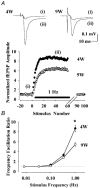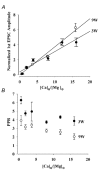Developmental decrease in synaptic facilitation at the mouse hippocampal mossy fibre synapse
- PMID: 12963803
- PMCID: PMC2343498
- DOI: 10.1113/jphysiol.2003.045948
Developmental decrease in synaptic facilitation at the mouse hippocampal mossy fibre synapse
Abstract
Transmission at the hippocampal mossy fibre (MF)-CA3 pyramidal cell synapse is characterized by prominent activity-dependent facilitation, which is thought to provide a wide dynamic range in hippocampal informational flow. At this synapse in mice the magnitude of paired-pulse facilitation and frequency-dependent facilitation markedly decreased with postnatal development from 3 weeks (3W) to 9 weeks (9W). Throughout this period the mean amplitude and variance of unitary EPSCs stayed constant. By altering extracellular Ca2+/Mg2+ concentrations the paired-pulse ratio could be changed to a similar extent as observed during development. However, this was accompanied by an over 30-fold change in EPSC amplitude, suggesting that the developmental change in facilitation ratio cannot simply be explained by a change in release probability. With paired-pulse stimulation the Ca2+ transients at MF terminals, monitored using mag-fura-5, showed a small facilitation, but its magnitude remained similar between 3W and 9W mice. Pharmacological tests using CNQX, adenosine, LY341495, H-7 or KN-62 suggested that neither presynaptic receptors (kainate, adenosine and metabotropic glutamate) nor protein kinases are responsible for the developmental change in facilitation. Nevertheless, loading the membrane-permeable form of BAPTA attenuated the paired-pulse facilitation in 3W mice to a much greater extent than in 9W mice, resulting in a marked reduction in age difference. These results suggest that the developmental decrease in the MF synaptic facilitation arises from a change associated with residual Ca2+, a decrease in residual Ca2+ itself or a change in Ca2+-binding sites involved in the facilitation. A developmental decline in facilitation ratio reduces the dynamic range of MF transmission, possibly contributing to the stabilization of hippocampal circuitry.
Figures







Similar articles
-
Kainate receptor-dependent short-term plasticity of presynaptic Ca2+ influx at the hippocampal mossy fiber synapses.J Neurosci. 2002 Nov 1;22(21):9237-43. doi: 10.1523/JNEUROSCI.22-21-09237.2002. J Neurosci. 2002. PMID: 12417649 Free PMC article.
-
Calcium-dependent mechanisms involved in presynaptic long-term depression at the hippocampal mossy fibre-CA3 synapse.Eur J Neurosci. 1999 May;11(5):1633-8. doi: 10.1046/j.1460-9568.1999.00578.x. Eur J Neurosci. 1999. PMID: 10215916
-
Associative mossy fibre LTP induced by pairing presynaptic stimulation with postsynaptic hyperpolarization of CA3 neurons in rat hippocampal slice.Eur J Neurosci. 2003 Apr;17(7):1425-37. doi: 10.1046/j.1460-9568.2003.02563.x. Eur J Neurosci. 2003. PMID: 12713645
-
Postnatal maturation of mossy fibre excitatory transmission in mouse CA3 pyramidal cells: a potential role for kainate receptors.J Physiol. 2004 Nov 15;561(Pt 1):27-37. doi: 10.1113/jphysiol.2004.069922. Epub 2004 Sep 9. J Physiol. 2004. PMID: 15358807 Free PMC article.
-
Ca2+ buffer saturation underlies paired pulse facilitation in calbindin-D28k-containing terminals.Neuron. 2003 Apr 10;38(1):79-88. doi: 10.1016/s0896-6273(03)00196-x. Neuron. 2003. PMID: 12691666
Cited by
-
Timing and efficacy of transmitter release at mossy fiber synapses in the hippocampal network.Pflugers Arch. 2006 Dec;453(3):361-72. doi: 10.1007/s00424-006-0093-2. Epub 2006 Jun 27. Pflugers Arch. 2006. PMID: 16802161 Review.
-
Prominent facilitation at beta and gamma frequency range revealed with physiological calcium concentration in adult mouse piriform cortex in vitro.PLoS One. 2017 Aug 18;12(8):e0183246. doi: 10.1371/journal.pone.0183246. eCollection 2017. PLoS One. 2017. PMID: 28820903 Free PMC article.
-
Reversal of hippocampal neuronal maturation by serotonergic antidepressants.Proc Natl Acad Sci U S A. 2010 May 4;107(18):8434-9. doi: 10.1073/pnas.0912690107. Epub 2010 Apr 19. Proc Natl Acad Sci U S A. 2010. PMID: 20404165 Free PMC article.
-
Increased expression of axogenesis-related genes and mossy fibre length in dentate granule cells from adult HuD overexpressor mice.ASN Neuro. 2011;3(5):259-70. doi: 10.1042/AN20110015. ASN Neuro. 2011. PMID: 22004431 Free PMC article.
-
Chronic variable physical stress during the peripubertal-juvenile period causes differential depressive and anxiogenic effects in the novelty-seeking phenotype: functional implications for hippocampal and amygdalar brain-derived neurotrophic factor and the mossy fibre plasticity.Neuroscience. 2011 Sep 29;192:334-44. doi: 10.1016/j.neuroscience.2011.06.077. Epub 2011 Jul 2. Neuroscience. 2011. PMID: 21767611 Free PMC article.
References
-
- Amaral DG, Dent JA. Development of the mossy fibers of the dentate gyrus. 1. A light and electron microscopic study of the mossy fibers and their expansions. J Comp Neurol. 1981;195:51–86. - PubMed
-
- Anderson AE, Hrachovy RA, Antalffy BA, Armstrong DL, Swann JW. A chronic focal epilepsy with mossy fiber sprouting follows recurrent seizures induced by intrahippocampal tetanus toxin injection in infant rats. Neuroscience. 1999;92:73–82. - PubMed
-
- Bertram R, Sherman A, Stanley EF. Single-domain/bound calcium hypothesis of transmitter release and facilitation. J Neurophysiol. 1996;75:1919–1931. - PubMed
Publication types
MeSH terms
Substances
LinkOut - more resources
Full Text Sources
Research Materials
Miscellaneous

